All about orchid roots
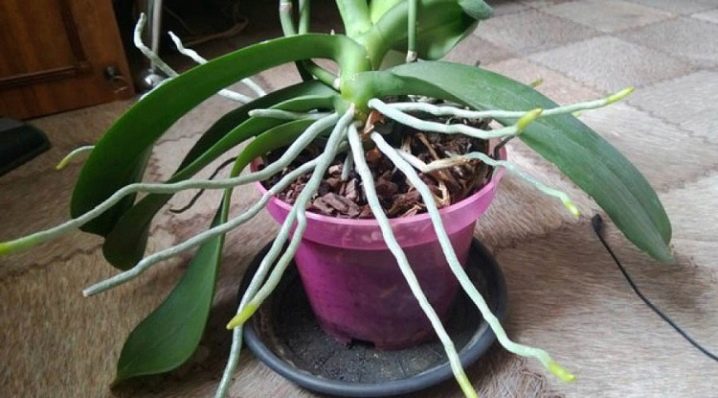
For any plant, the roots perform one of the main functions: they accumulate and deliver nutrients for the proper formation of leaves and stems. If something happens to them, the whole body suffers. Orchids are no exception, although their root system is significantly different from the roots of other plants. This is worth paying attention to when keeping a flower. In case of loss of roots, resuscitation is required, that is, their growth.
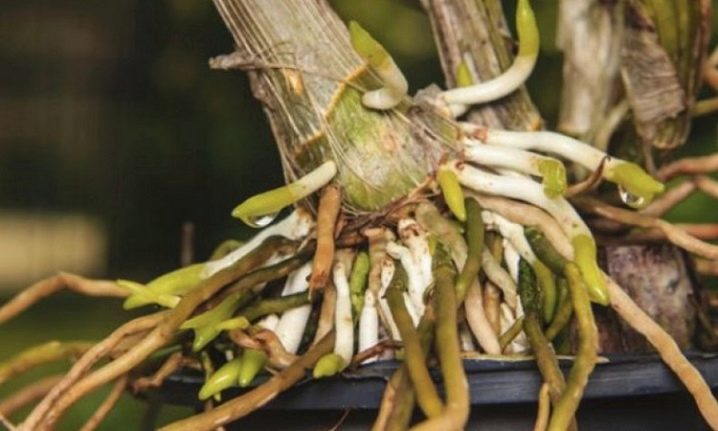
What do healthy roots look like?
The root system of the orchid family is formed in a completely different way than that of other plants. This is determined by the special way of life of orchids in their natural environment, where they do not take root in the ground, but grow on stones or trees. Some species have long shoots that twine around trunks or branches. Since they do not take root in the ground, they take nutrients and moisture from the air, leaves and bark of trees. Some of them are dipped into the substrate, the rest are located on the surface, collecting moisture and taking part in photosynthesis, thereby fulfilling the purpose of the leaves.
Due to these abilities, the root system of orchids does not have a need for rhizoderm with root hairs, which are involved in the absorption of moisture and minerals dissolved in it. The surface of the roots is covered with velamen - a spongy tissue with keratinized cells. Healthy orchid roots have:
- growing tip;
- velamen is light green.
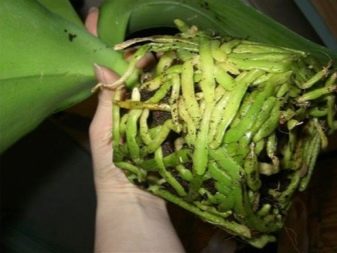

And also the roots have an elastic texture: when pressed, they hold their shape. The roots should completely fill the space of the pot. You can check this by slightly touching the plant: if it holds well, then there are enough of them, and if the fixation is loose, then the roots have to be increased. If the orchid has released a large number of roots, and they grow out of the container, the plant must be transplanted into a larger pot.
Orchids growing at home, in addition to underground roots, also have aerial ones growing above the ground. Their presence is considered the norm and should not frighten beginner growers. They are somewhat thicker than usual, flat and cylindrical in shape. Aerial roots are also covered with velamen, with the help of which they extract useful substances from the environment.
When wet, they are bright green, and when dry, they are silvery.

Can I trim them?
Many orchid lovers do not know what to do with a large number of overgrown aerial roots: whether to cut them off or let them grow. It is worth noting that they take part in the accumulation of trace elements necessary for the flower, their pruning can cause a decrease in the nutrition of the orchid. This will have a bad effect on the condition of the flower. If the root interferes with the growth of the leaf or begins to rot, it must be removed. The removal procedure is carried out with a sharp sterilized instrument as follows:
- cut off all rotten parts without exception;
- the sections are treated with an antiseptic or crushed charcoal.
After that, the plant does not need to be watered for several days so that rotting does not recur.
The reason for the appearance of a large number of aerial roots may be low humidity in the room: the orchid tries to absorb more nutrients. This happens more often in winter during the heating season, when heating devices dry the air.In this way, the plant is trying to adapt to new conditions. The best solution would be to move the flower to another place or increase the humidity in the room.
This can be achieved by installing a container with water next to the plant, and also to save moisture, the roots are covered with moss on top.
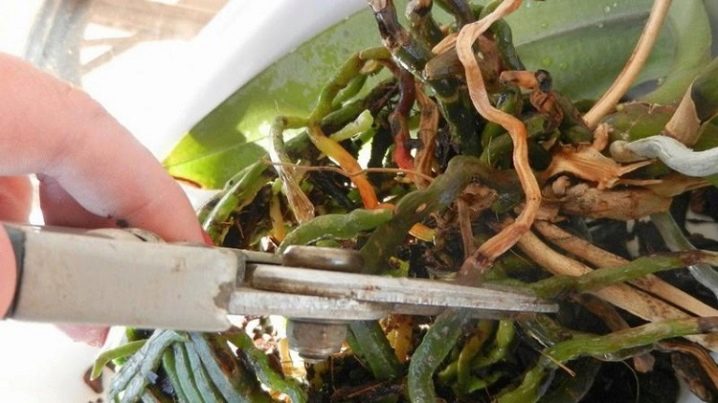
Symptoms of diseases of the root system
Since the orchid is an exotic flower, in unusual conditions for it, a tendency to disease often appears. And often the problems of the root system are rotting or drying out of the roots. They rot mainly due to improper moisture: as a result of excessive watering, moisture does not have time to be absorbed and is retained in the pot. If the roots have turned black, this means that they are disappearing and must be urgently pruned.
Under natural conditions, orchids grow in an environment where changes in humidity are quite frequent, therefore, in the course of evolution, they have formed enough ways to protect against drying out. Therefore, constant hydration is unnecessary. In addition, periods without watering will intensify the formation of peduncles. During the dormant period, the plant also needs to reduce the intake of moisture.
The roots become dry in two cases:
- lack of moisture;
- a burn with fertilizers with too much saturation or improper selection.
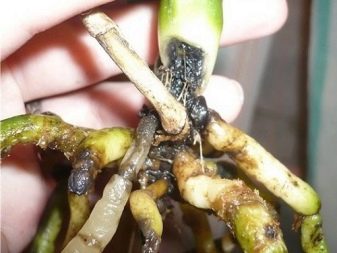
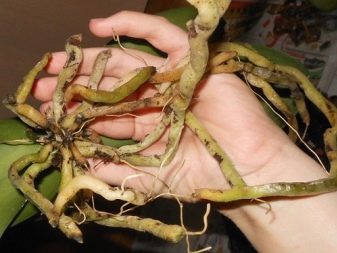
At the first problem, the roots need to be rinsed in water at room temperature and well moistened. In case of burns, the orchid must be transplanted into a different soil, less aggressive. The affected parts that cannot be reanimated are removed without fail in both cases. Finding out which roots to cut is pretty easy.
- The rotten ones are yellowish brown, slippery and too flexible. This indicates that they are empty inside, only the shell remains, and they can no longer be restored. Be sure to trim them above the affected area.
- Shrunken ones also become yellow, hard and brittle. You cannot break them off so as not to damage the stems. It is necessary to cut off with a knife or secateurs and process the cuts with chopped charcoal.
The yellow or brown color of the roots does not always indicate their disease. In some cases, they change color due to lack of sunlight or substances that they absorb from the substrate.
With root diseases, all parts of the plant suffer, in particular, the leaf plates: they become shriveled, lose their shape and color.
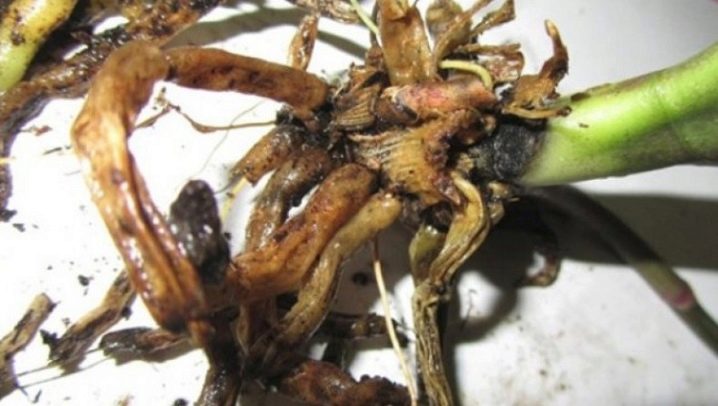
When the root system is overdried, the turgor of the leaves, that is, their normal state, can be restored by soaking the roots. The orchid is removed from the substrate, the roots are washed, immersed in a container of 30–35 ° water and left for a while (no more than 6 hours). You can carry out this procedure for several days in a row, but then the time spent in the water should not exceed 2 hours. Foliar dressing will also help to return turgor, which is used in the case of severely damaged roots or in case of an urgent need to restore the stem. Liquid nutrients are applied to the surface of the leaves, thereby promoting their renewal.
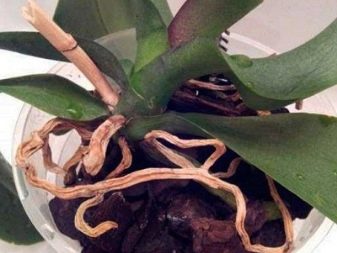
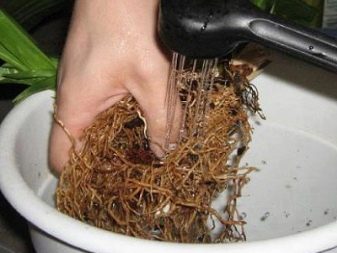
It happens that the leaves and roots of the flower are covered with a white bloom. This is how mold, a fungal disease of plants, manifests itself. It appears from excessive moisture or high temperature in the room, as well as when purchasing an already infected flower in a store. Quite often, the roots of a seemingly healthy plant are covered with white dots or balls. Whitish stains of varying sizes can be caused by the hardness of the water. Salts deposited in the soil prevent air from entering the cells of the root system normally, this is manifested by white dots on the roots and in the substrate. Small balls are the mycelium of soil fungi, this form serves as a protective barrier against adverse influences from the outside. When a suitable environment is formed, they grow and cover the roots of the plant and soil with cobwebs, taking nutrients from it.
If you do not take measures against the spread of fungi, over time, the roots of the plant die off. And also due to unsatisfactory conditions of maintenance, the roots of the orchid may become white. In such cases, the plant is transplanted and in the future, all the rules for the necessary care are observed.
A small number of roots in a plant is also a reason for urgent resuscitation of an orchid, since it does not receive nutrients and may die.
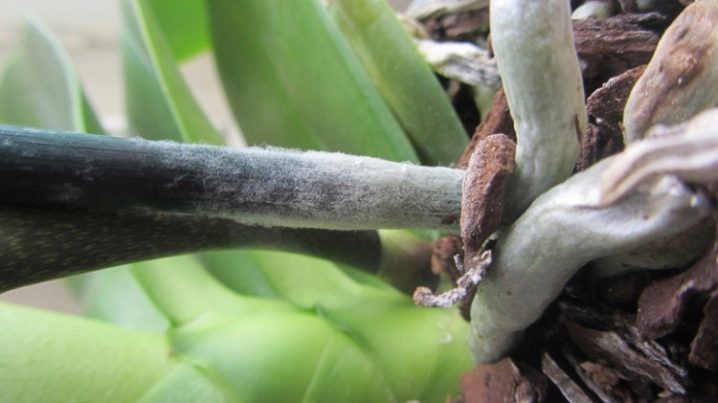
How to treat?
Rotten and dry roots are subject to mandatory removal, since they cannot be resuscitated. Slightly damaged ones are cut off slightly above the sore spot so that the disease does not spread. You can save the root system of an orchid even when there are several roots left. First of all, it is necessary to disinfect the instruments - a sharp knife or pruner - and remove all affected parts, without exception, leaving only living roots. All trimmed parts must be disinfected with fungicide powder or chopped charcoal. Common cinnamon has proven to be a good antiseptic. It is not necessary to cut off dried leaves or leaves that have lost their freshness. You can cut the peduncles, but it is still better to leave the lower part.
You can grow the roots using the greenhouse method, that is, when greenhouse conditions are created for the flower: optimal indicators of heat and humidity, diffused light. A cropped plastic bottle is used as a greenhouse, preferably of a large volume, which is placed in a sunny place, but protected from the scorching sun. A small amount of expanded clay is poured into it, sphagnum moss and then an orchid are placed on it. The temperature regime of the room is maintained within + 22 + 28 °. Every day, the bottle is opened for airing, and a glass of hot water is placed inside to maintain the required humidity level.

After two weeks, new roots begin to appear. The process of forming strong roots can take from a month to a year. When the roots have grown to 4–5 cm, the orchid is ready for potting. Most experienced florists recommend growing the root system in water. This method has several options:
- alternation;
- above the water;
- upside down.
For alternation, take a transparent or plastic glass. Its size is selected so that the base of the roots does not touch the bottom. Every day, the container is filled with warm water so that it covers the roots, and left for 6-10 hours. Then the water is drained. The next day, the procedure is repeated. Preparations containing phosphorus and potassium can be added to the water to promote rapid growth.
In the second method, the plant is placed in a bowl of water, to which sugar, honey or glucose is added (1 tsp per 1 liter of water). The base of the roots is above the liquid, without touching it; the vessel is closed from above. Every day, the roots are immersed in sweetened water for an hour, pulled out, dried and set back over water.
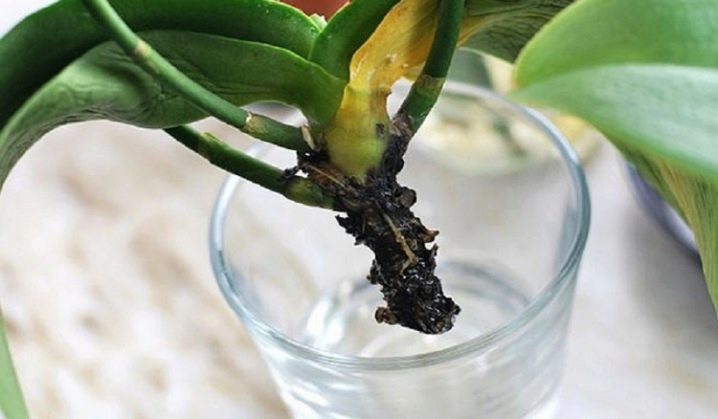
When restoring with the roots upwards, the flower is immersed in a glass of water with the leaves down by a third. Every day, the base of the roots is sprayed with warm water from a spray bottle, to which activated carbon is added. After a month, the first roots appear. After that, the plant is placed in a pot on sphagnum for further growth. With this method, not only roots grow dynamically, but also new leaves develop.
Florists often carry out resuscitation of orchid roots in a specially prepared substrate. This option is good both for flowers with several weak roots, and for plants whose roots have fallen off. First of all, the substrate must be well moistened, it is advisable to sprinkle the leaf plates with a solution of vitamin B1 to improve growth. The soil can be used in several types:
- finely crushed tree bark, steamed and dried;
- a combination of small pieces of expanded clay (as drainage), crushed bark and moss;
- compressed sphagnum moss.
In the absence of roots, their growth will last 10–12 months, and small roots will grow much earlier.
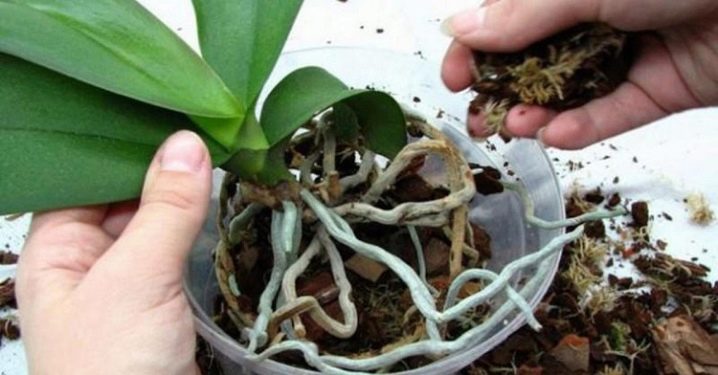
Care
With the correct implementation of all the manipulations and patience, the plant will recover over time and take on an even more beautiful appearance. To achieve the best result and stimulate the growth of the root system, it is worth using special preparations that dissolve in warm water. In addition to activating root formation, they promote faster rooting and serve as plant nutrition. Among the most popular and effective are the following stimulants, which I take in proportion to 1 liter of water:
- Ribav-extra - 2 drops;
- Zircon - 4 drops;
- Radifarm - 1 drop;
- Etamon - 1 ampoule;
- "Kornevin" - 1 g.

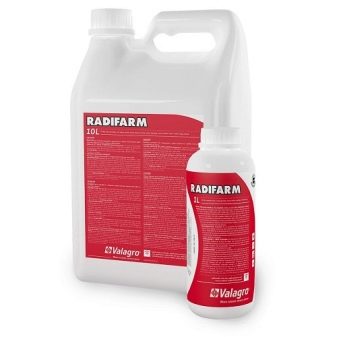
In order for the root regeneration process to be successful, certain conditions must be observed:
- the place where the plant is located should be well lit, but not in direct sunlight;
- the humidity is sufficient, not excessive;
- do not process sections with iodine solution or brilliant green to avoid burns;
- do not remove slightly dried and withered leaf plates: the plant takes useful substances from them.
































The comment was sent successfully.